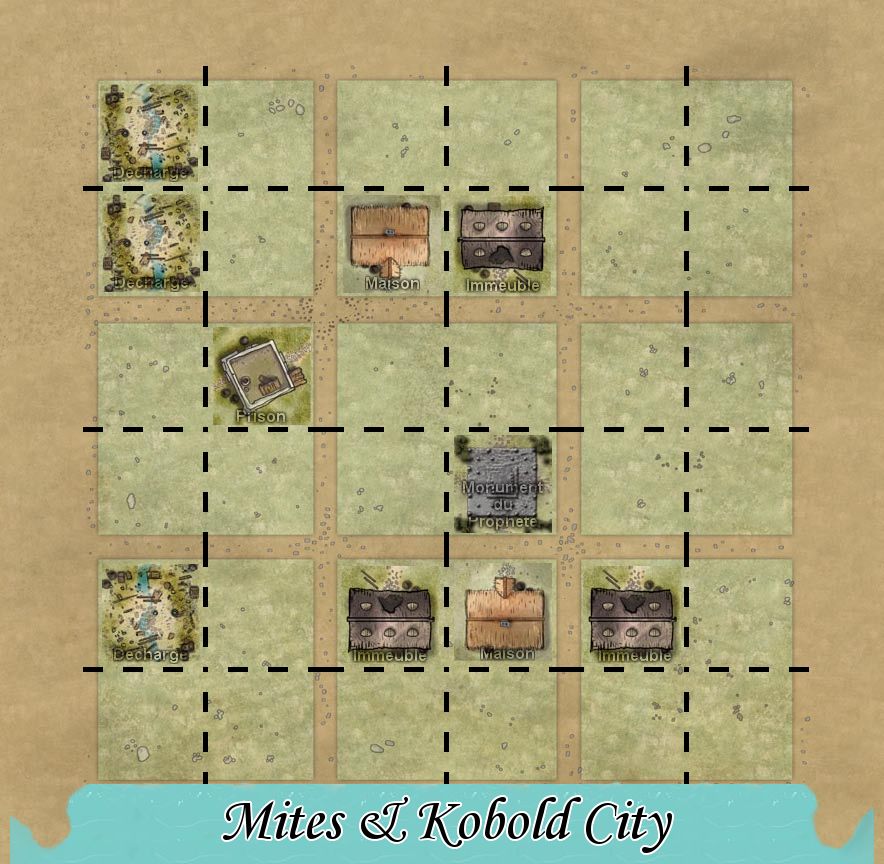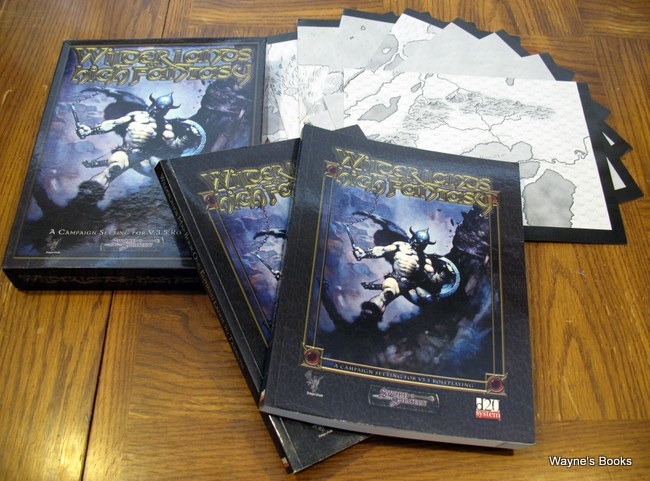Depuis quelques temps déjà, au club, nous jouons la campagne Pathfinder Kingmaker. La promesse faite dans cette campagne c'est de livrer aux joueurs un bout du monde de Golarion qu'ils pourront explorer à leur guise, puis y établir leur propre royaume. Je vais développer un peu plus mon ressenti par rapport à deux points qui font la particularité de cette campagne : la gestion de royaume d'une part, et le jeu en mode bac à sable d'autre part.
 |
| La carte de notre royaume, Erastion, dans les Terres volées, à la fin du Tome 3 |
Après avoir joué les 3 premiers tomes de la campagne, je constate que la partie gestion de royaume ne m'attire pas particulièrement. Je trouve que cela ajoute beaucoup de lourdeur à nos séances de jeu, heureusement qu'elle est gérée en grande partie par une feuille excel automatisée (et aussi par un joueur qui s'est porté volontaire pour faire le presse bouton...). Je pense qu'il est probablement possible de faire de cette partie de la campagne quelque chose de très bien, mais la mayonnaise ne prend pas.
De l'autre côté, la campagne se joue en mode "bac à sable" : une carte avec des hexagones, chaque changement d'hexagone prend un jour de voyage, puis quelques jours à explorer. Parfois il n'y a rien, parfois il y a une "rencontre". Jusqu'à présent, nous n'avons pas vraiment eu de rencontres aléatoire - ce n'est pas le style de notre MJ : ce sont donc celles prévues dans le scénario écrit. Globalement, ces rencontres sont courtes : il me semble équivalent à un gros combat typique à FP égal au niveau du groupe ou juste au dessus. Or comme généralement ce sera la seule rencontre du jour, les joueurs ont tendance à y mettre le paquet, lancer tout leurs plus gros sorts, etc. Il en résulte un problème d'équilibre, car le niveau de difficulté prévu (en tout cas dans la 3ième édition) est basé sur un système de en moyenne 4 rencontres de FP par jour, ce qui suppose que les joueurs fasse un minimum de gestion de ressources. En gros si le magicien lance tout ses plus gros sorts lors du premier combat de la journée, il risque de manquer de munitions lors du 3° et 4° combat de la journée... Dans Kingmaker, 90% du temps, cette contrainte n'existe pas du tout car une fois l'hexagone en court terminé, il faudra de toutes façon une journée de voyage pour aller au suivant.
De plus, comme le groupe est libre d'explorer la carte d'un tome de la campagne dans l'ordre de son choix, qu'un tome couvre globalement 2-3 niveaux d'expérience, il est possible de faire des rencontres au niveau de difficulté assez variable : nous avons déjà eu le cas où en fin de tome nous avons eu des rencontres très faciles (groupe niveau 9, rencontre FP6) qui n'auraient pas eu de sens à être jouées. C'est un peu le défaut du mode bac à sable qui ressort là. D'un autre côté, nous ne sommes pas non plus complètement libres : il y a une trame scénaristique qui court dans chaque tome de la campagne, et la "zone de jeu" est limitée dans sa taille. Je me rends compte que la partie exploration libre était probablement ce qui m'attirait le plus et que celle ci n'est peut être pas ce à quoi je m'attendais. Je comprends bien entendu le besoin de limiter le cadre de la campagne à un zone réduite, afin que cela n'empiète pas sur les tome suivants, dont les auteurs sont différents et sont destinés à être joués plus tard.
 |
| Ma ville préférée : peuplée de Mites et de Kobolds, qui vivent au milieu des décharges... |
Je ne voudrais pas que cet article laisse penser que je n'ai pas apprécié la campagne, ou le travail de notre MJ. Quand il s'agit d'incarner mon magicien chétif et pleutre, je me retrouve comme le gamin de 15 ans que j'étais quand j'ai commencé le JDR il y a fort longtemps. Merci à Gontrand, Ménas, Tom le vagabond, Rand Ohm et leurs joueurs respectifs pour tout ces bons moments, j'espère que nous poursuivrons jusqu'au bout l'histoire du royaume d'Erastion ! Sans oublier de remcercier le MJ qui n'a pas terminé de nous en faire baver...
En tout cas cela m'a fait ressortir ma boite de wilderlands of high fantasy. En gros, il s'agit d'un coffret contenant 2 gros volumes et une dizaines de grandes cartes à hexagones. Pas de scénario, pas de blabla, juste des descriptions d'hexagones. Ici un village, décrit succinctement à base de caractéristiques brutes (90% d'humains, 5% de nains etc., 750po de limite de richesse, PNJs notables...), sur cet autre hexagone une rencontre qui ne prend pas plus d'un paragraphe : un trône de pierre magique, un trésors de pièces d'or éparpillées dans les hautes herbes, une nuée de scorpions géants. Au MJ et aux joueurs de faire quelque chose de tout ça. C'est une possibilité que je garde pour le groupe dont je suis (occasionnellement) le MJ et avec qui nous allons bientôt terminer la campagne Second Darkness.
Un exemple de carte (oui chaque hexagone a un numéro mais tous les numéros n'ont pas quelque chose de spécial).
http://www.judgesguild.com/pdf/lenap/lenap_map.jpg
Je regarde aussi du côté des générateurs aléatoires. Je pense qu'il est possible, à l'aide de génération procédurale, suivi d'un peu de brodage, de faire quelque chose de très bien (par exemple pour pathfinder):
http://donjon.bin.sh/fantasy/world/
Lorsque je maîtrise Rogue trader, j'utilise un générateur aléatoire de système, issu de l'excellent Stars of Inequity, pour générer un cadre, ensuite je brode autour en ajoutant des choses. Je me suis rendu compte que ma réflexion est plus facile lorsque j'ai un élément de départ sur lequel cristalliser des idées. Dans le passé j'ai écrit des campagnes entières pour mes joueurs. Le plus difficile c'est au début, ça a toujours été de partir de rien, et de tout construire : trouver les noms, le cadre général, dessiner les cartes etc. Cela représente une somme de travail énorme. Avec ce système de génération aléatoire, il est possible de générer cette base. En général je génère plusieurs système avant d'en sélectionner un qui me semble le plus intéressant (en effet le côté aléatoire aboutit parfois à des chose assez moyennes).
 |
| Le système Ordal pour Rogue Trader, généré aléatoirement, et finalisé par mes soins |

























































